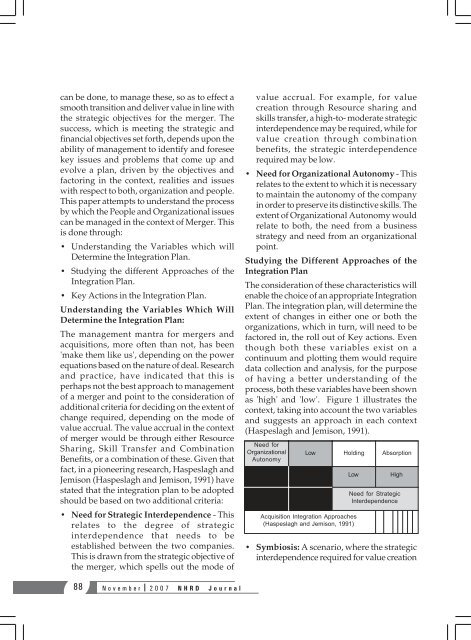NHRD Journal - National HRD Network
NHRD Journal - National HRD Network
NHRD Journal - National HRD Network
Create successful ePaper yourself
Turn your PDF publications into a flip-book with our unique Google optimized e-Paper software.
can be done, to manage these, so as to effect a<br />
smooth transition and deliver value in line with<br />
the strategic objectives for the merger. The<br />
success, which is meeting the strategic and<br />
financial objectives set forth, depends upon the<br />
ability of management to identify and foresee<br />
key issues and problems that come up and<br />
evolve a plan, driven by the objectives and<br />
factoring in the context, realities and issues<br />
with respect to both, organization and people.<br />
This paper attempts to understand the process<br />
by which the People and Organizational issues<br />
can be managed in the context of Merger. This<br />
is done through:<br />
• Understanding the Variables which will<br />
Determine the Integration Plan.<br />
• Studying the different Approaches of the<br />
Integration Plan.<br />
• Key Actions in the Integration Plan.<br />
Understanding the Variables Which Will<br />
Determine the Integration Plan:<br />
The management mantra for mergers and<br />
acquisitions, more often than not, has been<br />
'make them like us', depending on the power<br />
equations based on the nature of deal. Research<br />
and practice, have indicated that this is<br />
perhaps not the best approach to management<br />
of a merger and point to the consideration of<br />
additional criteria for deciding on the extent of<br />
change required, depending on the mode of<br />
value accrual. The value accrual in the context<br />
of merger would be through either Resource<br />
Sharing, Skill Transfer and Combination<br />
Benefits, or a combination of these. Given that<br />
fact, in a pioneering research, Haspeslagh and<br />
Jemison (Haspeslagh and Jemison, 1991) have<br />
stated that the integration plan to be adopted<br />
should be based on two additional criteria:<br />
• Need for Strategic Interdependence - This<br />
relates to the degree of strategic<br />
interdependence that needs to be<br />
established between the two companies.<br />
This is drawn from the strategic objective of<br />
the merger, which spells out the mode of<br />
value accrual. For example, for value<br />
creation through Resource sharing and<br />
skills transfer, a high-to- moderate strategic<br />
interdependence may be required, while for<br />
value creation through combination<br />
benefits, the strategic interdependence<br />
required may be low.<br />
• Need for Organizational Autonomy - This<br />
relates to the extent to which it is necessary<br />
to maintain the autonomy of the company<br />
in order to preserve its distinctive skills. The<br />
extent of Organizational Autonomy would<br />
relate to both, the need from a business<br />
strategy and need from an organizational<br />
point.<br />
Studying the Different Approaches of the<br />
Integration Plan<br />
The consideration of these characteristics will<br />
enable the choice of an appropriate Integration<br />
Plan. The integration plan, will determine the<br />
extent of changes in either one or both the<br />
organizations, which in turn, will need to be<br />
factored in, the roll out of Key actions. Even<br />
though both these variables exist on a<br />
continuum and plotting them would require<br />
data collection and analysis, for the purpose<br />
of having a better understanding of the<br />
process, both these variables have been shown<br />
as 'high' and 'low'. Figure 1 illustrates the<br />
context, taking into account the two variables<br />
and suggests an approach in each context<br />
(Haspeslagh and Jemison, 1991).<br />
Need for<br />
Organizational<br />
Autonomy<br />
Low<br />
Holding<br />
Low<br />
Acquisition Integration Approaches<br />
(Haspeslagh and Jemison, 1991)<br />
Absorption<br />
High<br />
Need for Strategic<br />
Interdependence<br />
• Symbiosis: A scenario, where the strategic<br />
interdependence required for value creation<br />
88<br />
November 2007 <strong>N<strong>HRD</strong></strong> <strong>Journal</strong>
















